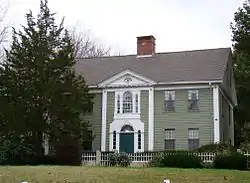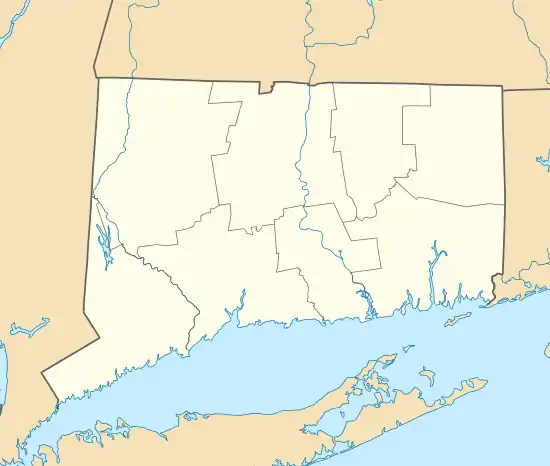Andrew Clark House | |
 | |
  | |
| Location | Ross Hill Road, Lisbon, Connecticut |
|---|---|
| Coordinates | 41°36′35″N 71°59′57″W / 41.60972°N 71.99917°W |
| Area | 3.2 acres (1.3 ha) |
| Built | 1798 |
| Architectural style | Georgian |
| NRHP reference No. | 79002636[1] |
| Added to NRHP | June 28, 1979 |
The Haskell House, also known as the Andrew Clark House, is a historic house on Ross Hill Road in Lisbon, Connecticut. Built about 1798, it is a good example of transitional Georgian-Federal residential architecture. It was listed on the National Register of Historic Places on June 28, 1979.[1]
Description and history
Haskell House, (a.k.a. “Andrew Clark House”) stands in a rural area of central Lisbon, on the west side of Ross Hill Road about 0.5 miles (0.80 km) north of Connecticut Route 138. It is a 2+1⁄2-story wood-frame structure built in 1798 by Capt. Andrew Clark. It is five bays wide with a side-gable roof and a large central chimney. A 1+1⁄2-story ell extending to the north was the original c. 1740 freestanding Morgan farmstead. A second ell to the west features a circa 1750 Rhode Island Cape that was dismantled and moved to the property in 1967 by prominent antiques dealers Jerome & Selma Blum as a sensitive contribution to the house. Much of the hardware and some of the floors from the Rhode Island house were used to complete the main house restoration. The most notable of the house's facade are a second-story Palladian window, an original, hand-carved gilded eagle ornament, a pavilion sheltering the main entrance and a massive granite surround topped with picket fencing. Although the basic structure of the main house is Georgian, its styling is more Federal, reflecting the transitional period of its 1798 construction date.[2]
Land for the house, along with the c. 1740 Morgan farmstead, was purchased in 1792 by Capt. Andrew Clark, a wealthy farmer who also served as a state representative. This house is presumed to have been built in 1798, based on the panel with that date in the chimney. The panel resembles a similar one in a house in the nearby village of Newent, suggesting the house was built by an itinerant craftsman. After Clark and his wife died (outliving all of their children), the house passed into the Haskell (or Herskell) family of her sister, Dolly Partridge Haskell.[2]
See also
References
- 1 2 "National Register Information System". National Register of Historic Places. National Park Service. March 13, 2009.
- 1 2 "NRHP nomination for Andrew Clark House". National Park Service. Retrieved 2015-01-21.